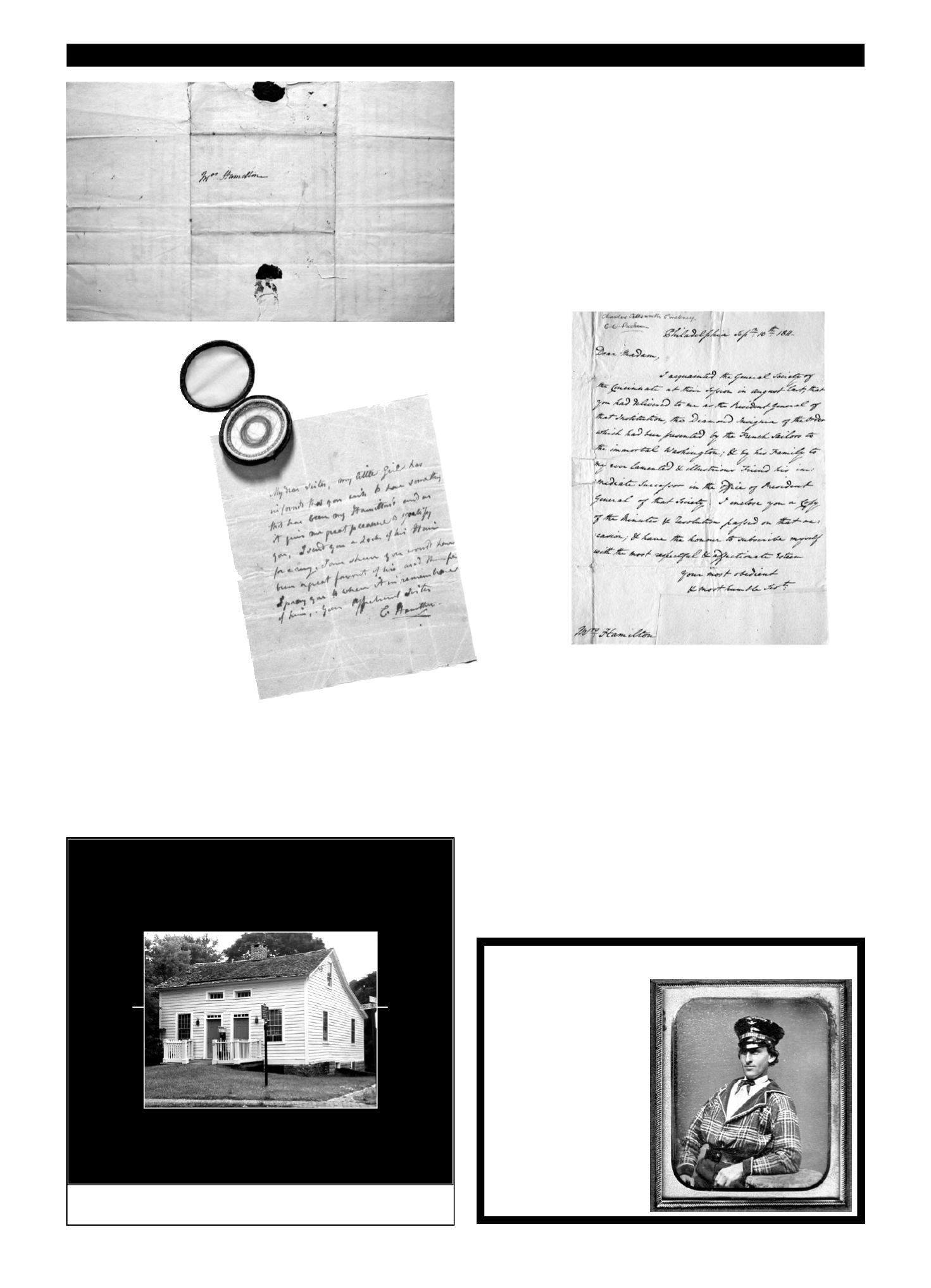

Maine Antique Digest, April 2017 29-B
-
AUCTION -
29-B
Charles Cotesworth Pinckney, president general of the Society of the
Cincinnati, wrote this letter to Elizabeth Schuyler Hamilton, thanking her
for entrusting the Society of the Cincinnati with its most precious emblem,
Washington’s jewel-encrusted insignia of the order. The letter sold in the
salesroom for $25,000 (est. $10,000/15,000) to the Society of the Cincinnati.
It is one page, 9¾" x 7½", written in Philadelphia, September 10, 1811, with
address leaf; the signature is clipped, both leaves have been remargined and
hinged together, a seal tear has been repaired, and it is tipped to a larger
leaf. According to the catalog, “Pierre L’Enfant had returned to Philadelphia
from Paris in 1784 with his first box of eagles and a special eagle ordered by
Washington himself. But that particular badge was eclipsed by a splendid
and unexpected gift from the French navy—an eagle set with 155 diamonds
of all sizes, 28 emeralds, ten rubies, and one blue sapphire, for a total of 194
precious stones. Henceforth Washington wore this bejeweled decoration as
his regular badge. Even as President of the United States he would appear at
his birthday functions in his old buff and blue uniform wearing the diamond
insignia. After his death, Martha Washington presented it to Alexander
Hamilton, who in 1800 succeeded Washington as President General of
the Cincinnati. Hamilton’s widow in turn sent it to Charles Cotesworth
Pinckney, who became President General in 1805; and in 1811 he gave it to
the society as its official badge of office. It has been worn to this day by every
subsequent President General.”
This is the signed condolence letter from Philip Schuyler to his daughter Elizabeth
Hamilton after Alexander’s duel with Aaron Burr. It is signed “I am and I always will be
your affectionate father.” The two pages on a bifolium, 13" x 8", were written in Albany,
July 20, 1804, and you can see the remnants of black sealing wax here. The letter states:
“Extream as my distress is, and indisposed as I have been, and still unwell, it has pleased
the divine being to support me in the severe tryals. Bishop Moore’s account of the last
moments of my dearly beloved son has conveyed great consolation to me and doubtless to
you my dear afflicted child. My Hamilton’s spirit is now in heaven and that of your parent
hopes in God’s due time to meet in the abodes of bliss. I have too long neglected the sacred
ordinances directed by our Savior, but I hope soon to become a partaker....” According to
the catalog, “Soon after Hamilton was conveyed to the Bayard household after the duel, he
asked to see Reverend Benjamin Moore, the rector of Trinity Church, the Episcopal bishop
of New York, and president of Columbia College, in order to receive last rites from him. At
first, Moore balked at giving Hamilton holy communion, because he had not been a regular
churchgoer and because he had engaged in the sinful and barbarous act of dueling.... With
Hamilton’s declaration of faith in God’s mercy and admission that he never intended Burr
any harm, Moore relented and gave him holy communion.” The condolence letter sold on
the phone for $43,750 (est. $15,000/25,000) to the buyer of the group of 34 Philip Schuyler
letters that sold for $125,000.
This is a lock of Alexander
Hamilton’s hair, accompanied
by an autograph letter signed
by Elizabeth Schuyler Hamilton,
“E. Hamilton,” presenting the
relic to her sister-in-law Mary Ann
Sawyer Schuyler. The 7½" x 6¼"
page, written in New York, 1807 or
after, bears an autograph address
on the back, “Mrs. Schuyler.” With
a small seal tear, some very light
creasing and wrinkling, and browned,
it sold on the phone for $37,500 (est.
$15,000/25,000). The hair is preserved
in a late 19th-century oval blue velvet
locket case, 2
⅛
" x 1
⅞
”. Eliza Hamilton
made frequent gifts of locks of her late
husband’s hair, as was the custom of the
day. The presentation reads: “My dear Sister, my little girl has informed that you
wish to have something that has been my Hamilton’s and as it gives me great pleasure
to gratify you, I send you a Lock of his Hair for a ring. I am shur you would have
been a great favourt of his and therefore pray you to wher it in remembrances of him.
Your Affectionate Sister.”
d
d
Now open 10-5 Thursday-Monday or by appointment.
(518) 309-3745
info@doubledayhouse.com doubledayhouse.com28 Washington Street
Ballston Spa, NY 12020
Storewide Discounts Available
Food & Beverage will be served
Doubleday House Antiques
Spring Open House
Saturday & Sunday - April 1-2
GregFrenchEarlyPhotography.comFEATURING
GALLERY 21
a rotating inventory
of fine 19th-century
photographs
If you prefer Ebay,
please look up
seller name
“Genest”
Daguerreotype of a Fireman
from the Gov. Brooks Engine Co.,
Medford, Mass.











